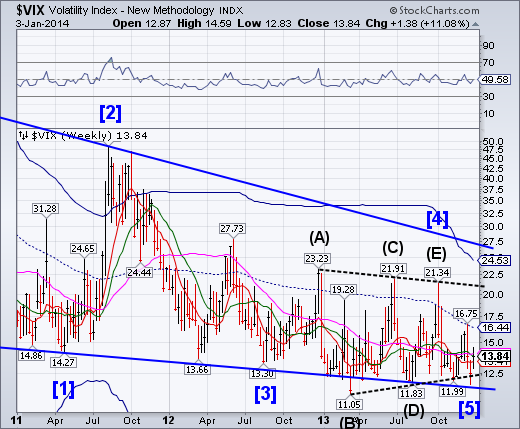
During Christmas Week it appears that VIX completed declining in a Primary Wave [5]. This week it closed at weekly Intermediate resistance at 13.84 and still has to overcome Long-Term resistance at 14.05, but the reversal appears real.Confirmation of a change in trend lies above that level with confirmation of the trend change at 16.44 to 16.75.
SPX reverses within the Broadening Top. 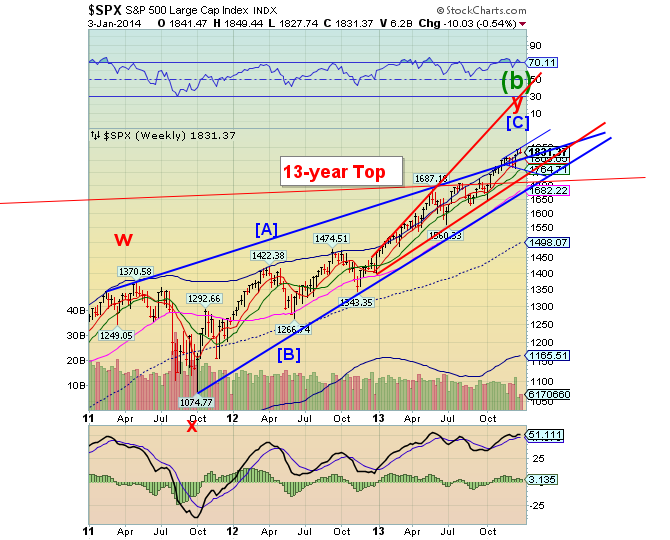
SPX made its final intraday high on December 31, then closed the week within the Orthodox Broadening Top, which began forming in mid-November. TheOrthodox Broadening Top is formed by three successively higher tops and two bottoms, the second of which must be lower than the first.This forms a “Megaphone” pattern. A decline from this peak through the bottom trendline of the Broadening Top completes the formation and sets up the initial downside target.
(ZeroHedge) The weakness in stocks accelerated after Europe's close, was briefly stalled by algo wildness and VWAP buys on Bernanke's completely non-news speech this afternoon, then dropped into the close, but was far outweighed by the moves in commodities.WTI Crude has dropped over 6% in the last 4 days - its biggest such drop in almost 8 months. The last 2 days have seen gold rise at its fastest pace in almost 3 months.
NDX closes the week at its trendline. 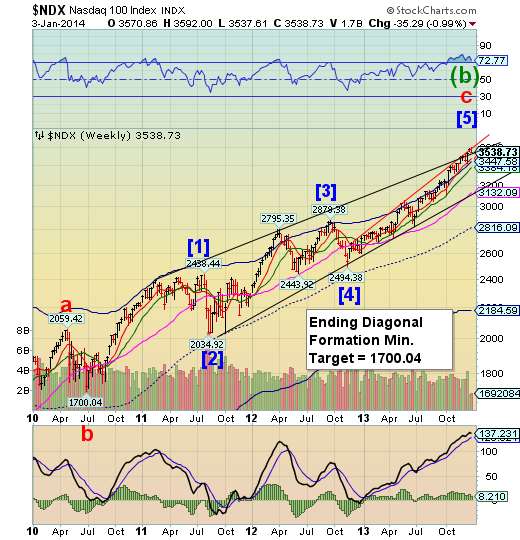
NDX closed the week at the upper trendline of its Ending Diagonal formation after making a new closing high on Tuesday. The 4.8 year rally may now be finished.Confirmation of that would come with a decline beneath the trendline followed by a further decline below the Cycle Top line at 3447.58.
(ZeroHedge) As we warned was likely to happen back in February of 2013 (given the typical trajectory of earnings expectations through a year), JP Morgan has confirmed that the S&P 500 is now more expensive on a forward P/E basis than it was at its peak in October 2007. So, despite the self-referential bias of each and every talking head asset-gatherer on mainstream media's denial, stocks do not offer value here... no matter how many TINAs or BTFATHs you hear...
The euro reverses at its Cycle Top.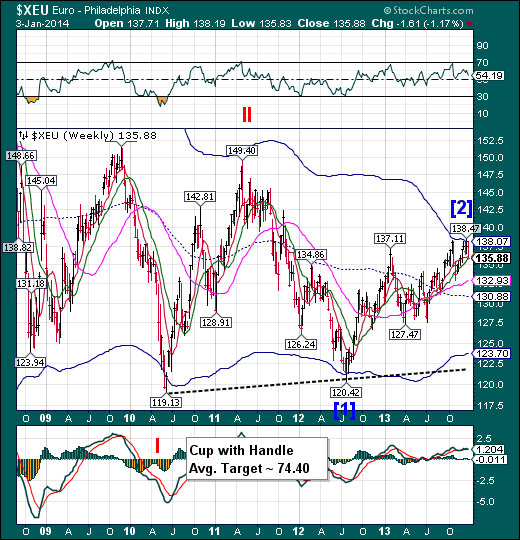
The euro reversed down this week after challenging its Cycle Top resistance at 138.07 for the past two weeks.It closed just above its weekly Intermediate-term support at 135.81.Final support is at 132.93 and 130.88, beneath which the Euro decline may accelerate.
(ZeroHedge) One of our favorite themes in the past year has been watching Mario "Whatever it takes" Draghi reel powerless before the relentless contraction in Eurozone credit. Most recently, in November we reported that "when the ECB announced a "surprising" rate cut, 67 out of 70 economists who never saw it coming, were shocked. We were not. As we observed ten days prior, Europe had just seen the latest month of record low private sector loan growth in history. Or rather contraction.
The yen is now testing its Head & Shoulders neckline. 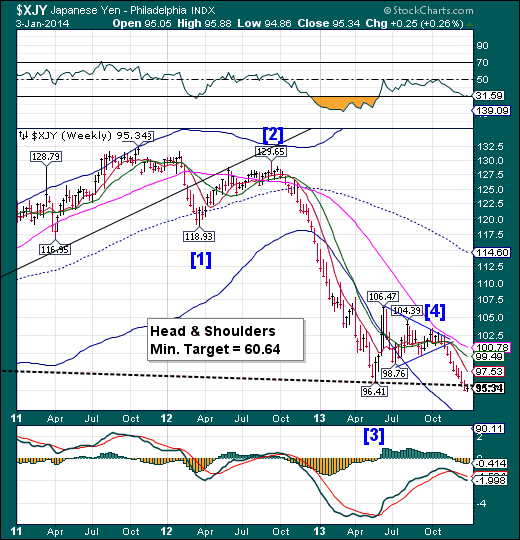
The yen slipped below the Head & Shoulders neckline at 96.00over the holidays.Itappears to be breaking down beneath the neckline in a Primary Wave [5] in a very strong decline that may last through mid-February.
The US dollar closed above mid-Cycle resistance. 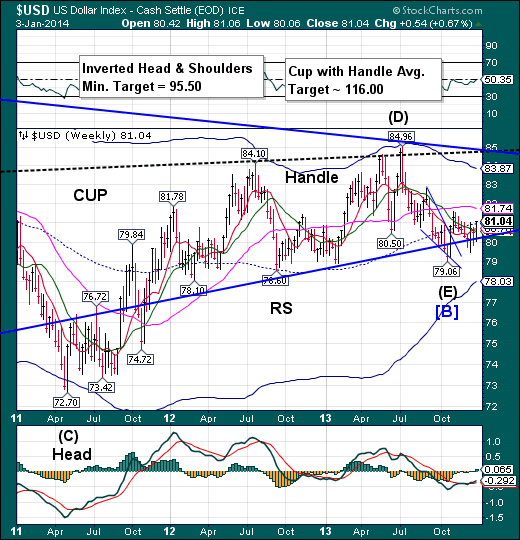
The USD closed above its weekly mid-Cycle resistance at 80.95 and has closed above its December high. The Cycle Model suggests the next phase of the rally lasting through late January that may bring the USD above its inverted Head & shoulders pattern shown in the chart.Thebear trap for dollar shortshas now been sprung.
Gold bounces from a new Head & Shoulders formation. 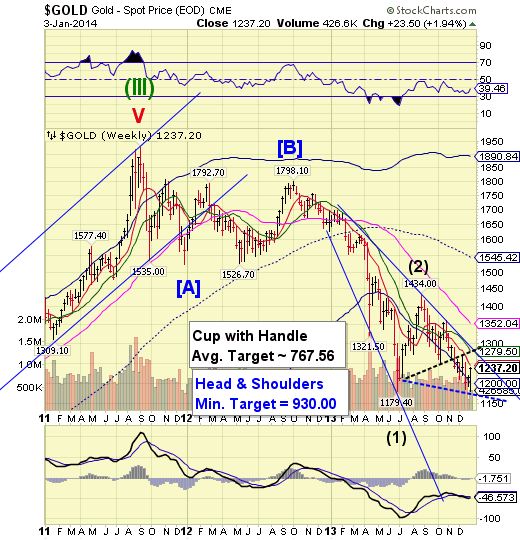
Gold bounced from its new Head & Shoulders neckline at 1181.40 and appears to have stoppedits retracement just under Short-term resistance at 1243.77.Indications are that gold may turn back down early next week. A bearish Cup with Handle formation has already been triggered, so any additional rally may be limited in breadth.
(ZeroHedge) Sales of gold coins are booming even as the precious metal's price is falling (and it's not just central banks). Despite gold futures 28% drop in 2013 (its worst since 1981), the WSJ reports that demand for gold coins shot up 63% to 241.6 metric tons in the first three quarters of 2013.
Treasuries decline beneath the Broadening Wedge. 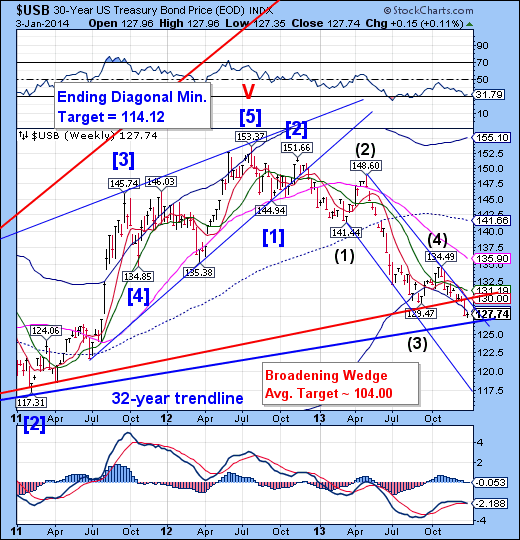
The USB declined beneath the trendline of its massive Broadening Wedge formation and may be threatening its 32.25-year trendline.The Broadening Wedge suggests a probable 20% loss beneath this support level.More importantly, the loss of a long term uptrend is in jeopardy.
(Bloomberg) Treasury yields traded at almost the highest levels since 2011 as Federal Reserve Chairman Ben S. Bernanke said the headwinds that have held back the U.S. economy may be abating, leaving the country poised for faster growth.
Crude has a mighty reversal this week. 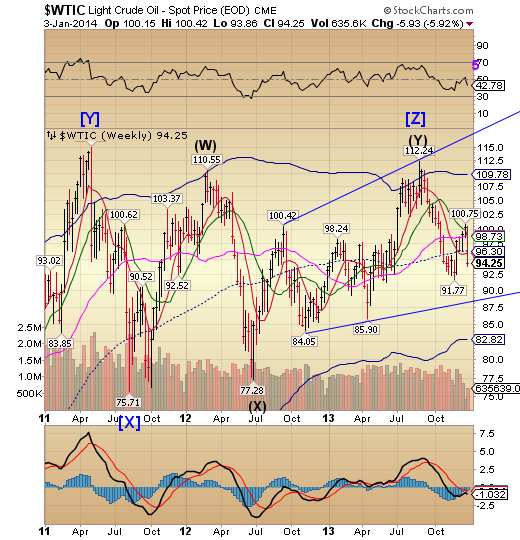
Crude plunged nearly 6% in two days, turning a mildly bullish outlook in WTIC to bearish.This implies that further downside beneath the prior low at 91.77 may confirm that a downtrend is already in place. Upside movement, should it appear, may be inhibited by the overhead resistance between 94.25 and 98.73.
(Bloomberg) West Texas Intermediate crude fell, capping the biggest weekly decline in 19 months, after a government report showed that U.S. supplies of distillate fuel and gasoline climbed.Futures dropped 1.6 percent today and 6.3 percent this week. The Energy Information Administration said stockpiles of distillate fuel, including heating oil and diesel, rose 5.04 million barrels last week to 119.1 million. Gasoline inventories gained 844,000 barrels to 220.7 million. Fuel demand tumbled 7.2 percent, the most since January 2012. Crude supplies slid as Gulf Coast refiners curbed deliveries to reduce local taxes.
China stocks take a plunge.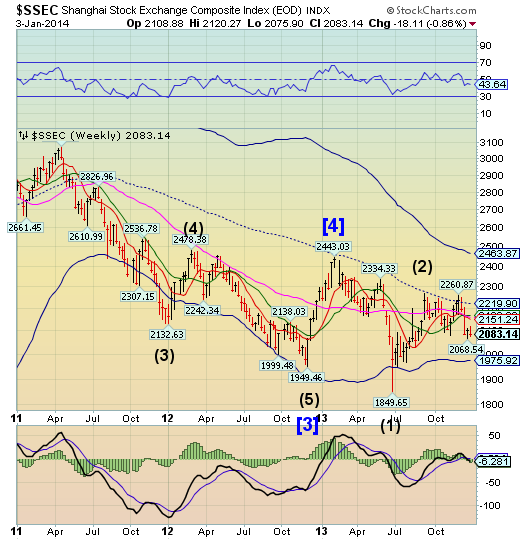
The Shanghai Index consolidated at new lows not seen since last Summer.SSEC may continue its decline through mid-January in what appears to be a growing liquidity crunch.In the process, it has a high probability of making some new lows. The duration of this decline may not be finished until mid-March..
(Reuters) - About 3.33 million hectares (8 million acres) of China's farmland is too polluted to grow crops, a government official said on Monday, highlighting the risk facing agriculture after three decades of rapid industrial growth.
China has been under pressure to improve its urban environment following a spate of pollution scares.But cleaning up rural regions could be an even bigger challenge as the government tries to reverse damage done by years of urban and industrial encroachment and ensure food supplies for a growing population.
The India Nifty retreats back to support. 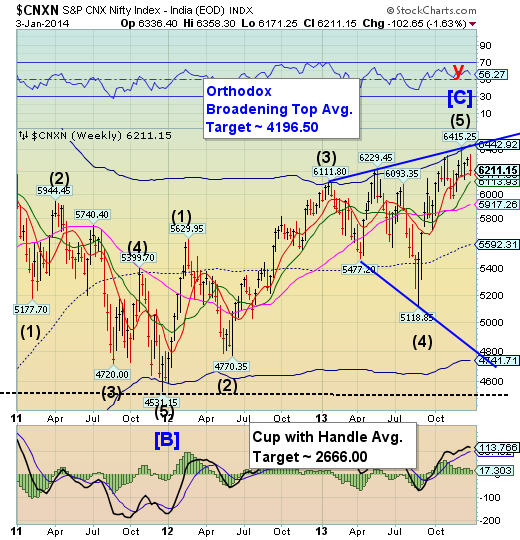
The India Nifty retreated back to Short-term Support at 6177.33 this week. The decline into early January came as expected and may continue through mid-February.Thisdecline may be deflationary to an extreme, since equities have become thoroughly saturated with liquidity from India’s central bank and simply cannot absorb any more.Indian investors are leveraged to the hilt. The potential for a panic decline to the weekly Cycle bottom (4741.71) is very high.
The Bank Index is still flying high.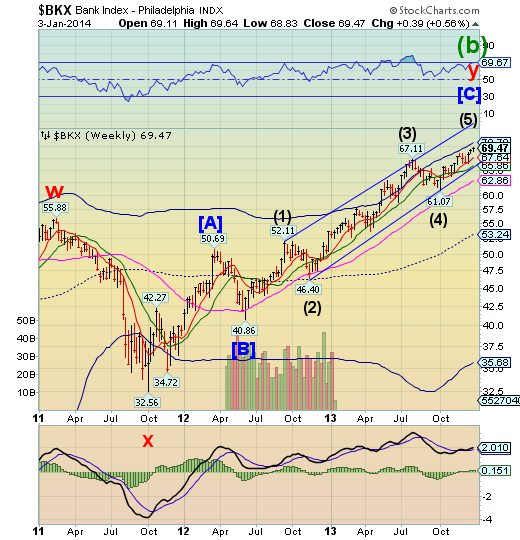
BKX has closed exactly at 50% of its decline from 2007 to 2009.The momentum oscillators are winding down and the 50% Fibonacci level may be all it takes for a reversal. The resumption of the secular bear market may be most spectacular in BKX.
(ZeroHedge) On December 31 we demonstrated the biggest operation in the history of the Fed's temporary open market operations: a $198 billion reverse repo under its brand new fixed-rate scheme, which, at least according to the Fed, was supposed to be a mechanism designed to prepare the market for the "normalization" of the Fed's balance sheet and allow seamless liquidity extraction. What the Fed did not announce was that it was also the biggest collateral window-dressing scheme ever conceived (that there was $200 billion in free liquidity sloshing around was a distant second highlight).
(TheEconomist) “NAUGHTY or nice” is not a discussion investment bankers have with Santa before Christmas but one they have with their bosses early in the new year. The haggling usually opens with the boss saying what a tough year it has been and the bankers, often experienced traders and dealmakers, talking about how valuable they are. This year’s negotiations will be unusually tense. At stake will not simply be pay, an issue complicated by the introduction on January 1st of a bonus cap in Europe, but also jobs.
After peaking at the end of 2010, employment in the investment-banking industry has been declining steadily. Deutsche Bank reckons that the number of bankers employed by the ten largest firms will fall by about 3,000 in 2014, leaving the total 20% below its peak. Add in job losses at smaller firms and declines in support staff, and total worldwide employment in the industry may fall by 20,000 this year.
(ZeroHedge) The ongoing debacle of Italy's Banca Monte deiPaschi (BMPS) took a turn for the worst today. The bank's largest shareholders (MPS Foundation) approved (read - forced through) a delay in a EUR 3 billion capital raise, which the bank needs to avoid nationalization, until May. The delay (which will cost the bank EUR 120 million in interest) allows MPS more time to liquidate their 33.5% holding before their stake is massively diluted. Management is 'considering' resignation and is "very annoyed," but the city Mayor is going Nationalist with his delay-supporting comments that "we cannot let the third biggest bank in this country fall prey to foreign interests." So Europe is recovering but they can't even raise a day's worth of POMO to save the oldest bank in the world?
